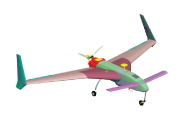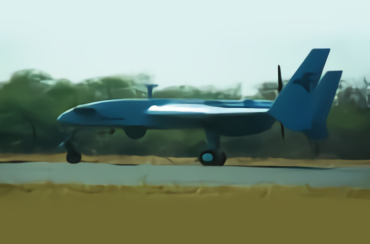Thank God.
WASHINGTON: Pakistan is making extensive and precise use of its own indigenous drones in the current surgical strikes against the Taliban, security officials and experts confirmed on Tuesday.
A top official said ground intelligence, combined with accurate data by the Pakistani drones, had made it possible to take out the TTP targets in Tirah and Mir Ali recently, creating a scare among the TTP ranks not seen before.
Sources in Islamabad say the telephone chatter after these strikes had shown that the Taliban were in disarray as they were telling each other if such precise strikes continued, they would be eliminated without even a fight.
A senior security official, when asked by me whether in the latest touch and go visit by the CIA chief Brennen to Rawalpindi, had the Pakistan Army asked for intelligence help from the US drone apparatus to pinpoint the TTP hideouts, the response was ‘no’.
“The CIA chief’s visit was just a courtesy call on the army chief but Pakistan is using its own ‘parindahs’ (birds) for the strikes that have been conducted. We have effective drones that can help immensely in such situations.”
The official was referring obviously to the capability Pakistan had announced in 2012 and confirmed in November 2013 when two locally-produced drones were displayed at an arms exhibition in Karachi.
According to a Washington Post report of the event onNov 26: “After years of preparation, the Strategically Unmanned Aerial Vehicles were formally announced by Gen Ashfaq Kayani, chief of Pakistan’s military. The drones, called ‘Burraq and Shahpar’, will not be armed and are to be used only for surveillance, military officials said.”
“The development of the drones, thought to have a range of about 75 miles, represents a milestone for the country’s military and scientists,” the Post quoted Pakistani and Western analysts.
“It is a landmark and a historic event, wherein a very effective force multiplier has been added to the inventory of the armed forces,” the Pakistani military then said in a statement.
Pakistan’s military first revealed its drone technology at a trade show in 2012, but in November last year the formal unveiling coincided with an ongoing farewell tour by Gen Kayani, who was retiring after two terms as army chief, the Post reported.
Brig Muhammad Saad, a former senior officer in the Pakistani military familiar with the subject, was quoted as saying that the country already had less-sophisticated drones for intelligence gathering, with a range of about six miles.
The newer models, he said, will prove useful for ‘collecting more operational intelligence’ that could help guide helicopter gunships and fighter jets to specific targets. This is a great achievement, and the drones can be used instead of surveillance jets and fighter jets that would be costlier to fly.”
Experts say Pakistan is still years away from being able to develop armed drones but Washington Post quoted Peter W Singer, a security analyst at the Brookings Institution, saying most surveillance drones can be armed, though they will lack the precision of US-developed models.
“Almost any unmanned system can be armed in a crude style, such as dropping a bomb or even turning it into an equivalent of a cruise missile that you fly into the target,” said Singer, adding that the announcement will probably add to growing fears about proliferation of drone technology.
In November of 2012, London’s Guardian newspaper reported that military officials had briefed some of Pakistan’s closest allies about efforts by the army to develop its own combat unmanned aerial vehicle (UAV).
“The foreign delegates were quite excited by what Pakistan has achieved,” said the official, who was closely involved with organising the four-day International Defence Exhibition and Seminar (Ideas). “They were briefed about a UAV that can be armed and has the capability to carry a weapon payload.”
The official said Pakistan wanted to demonstrate to friendly countries, principally Turkey and the Gulf, that it can be self-sufficient in a technology that is revolutionising warfare and which is currently dominated by a handful of countries that do not readily share the capability.
A Pakistan Army colonel, who had just finished a tour of the country’s border region, was quoted by the Guardian as saying such small drones were a vital tool. “We have these small drones, but not enough of them and we do not always get them when we have operations,” said the colonel in Nov 2012. “They are excellent for observing their movements and deployments.”
But now it is 2014 and the Pakistan Army has as many of these birds as it needs. This will be the latest and the most effective tool in this fight against terrorism.SHAHPAR
UAV System
Shahpar is a medium range tactical UAV System with autonomous take-off and landing. It can carry various types of payloads integrated for reconnaissance and day & night surveillance. Other features include accurate lateral , longitudinal trajectory control, mission planning , management & control , geo referencing & geo pointing for terrestrial targets.

Performance Characteristics
Configuration Canard pusher Air Vehicle Length 4.2 m Wing Span 6.6 m (22′) Gross T/O Weight 480 kg Payload Weight 50 kg Endurance > 7 hrs Max operating Altitude 5000 m (17000 ft) Approx. Cruise Speed 150kph Maximum power of engine 100hp Data link Range (real time) 250 km Guidance / Tracking Autonomous, GPS Based (manual control channel available) Take-off / launch Automatic, Wheel take-off Landing / recovery Automatic Landing, manual pilot and parachute option available Main Features
- Autonomous take-off and landing.
- Various types of payloads integrated for reconnaissance and day & night surveillance
- Accurate lateral and longitudinal trajectory control
- Mission planning, management & control
- Built-in data exploitation and dissemination
- Full mission debriefing & simulation
- Military standard hardware (Environmental Standard 810F)
- Geo referencing and geo pointing for terrestrial targets
- MISB compliant video format
UQAB UAV SYSTEM
Tactical UAV System
Uqab is a tactical UAV System which can be effectively used for battle damage assessment, aerial reconnaissance, artillery fire correction, joint forces operations, search and rescue missions, coastal area surveillance, route monitoring, internal security / mob control and flood relief operations etc. Presently the system is being used by Pakistan Security Forces.
Performance Characteristics
Range 150 km Endurance 6 hrs Height Ceiling 3,000 m Speed 120 ~ 150 km/hr Launch/Recovery Wheeled Flight Mode Autopilot/RPV 1000 way points, Re-programmable during flight Fail-safe mode, Loiter mode & User defined holding patterns Tracking/Navigation GPS Based Telemetry Data Real time digital video Position and health of UAV Geo-referencing Payload Weight/Type Gyro-stabilized gimbal with color day camera, thermal imager with target tracking and locking capabilities Power Plant 250 km Dimensions & Weight
Wing Span 5.5 m Length 4.0 m Height 1.2 m Max Takeoff Weight 200 kg (approx) Ground Control Station (GCS) for Uqab UAV
Ground Control Station is a truck mounted air-conditioned, insulated container which is equipped with standard, ruggedized consoles.
Characteristics
- User friendly mission planning and execution
- Mission de-briefing & simulation
- In-flight mission re-programming
- Flexible waypoints entry & editing during flight (direct from map & keypad)
- Mission parameter & flight data logger for post flight analysis & simulation
- Real time video and telemetry data
- Moving map software
- Geo-referencing
- Easy payload (camera) controls
- Separate consoles for mission commander, UAV pilot & payload operator
- Easy to read displays and gauges
- Standby control links (redundancy)
- Back-up power supply
COURTESY: GIDS http://gids.com.pk/shahpar http://gids.com.pk/uqab-uav
-
-
Archives
- August 2024
- May 2024
- March 2024
- February 2024
- January 2024
- December 2023
- November 2023
- October 2023
- September 2023
- August 2023
- July 2023
- June 2023
- May 2023
- April 2023
- March 2023
- January 2023
- December 2022
- November 2022
- October 2022
- September 2022
- August 2022
- June 2022
- May 2022
- April 2022
- March 2022
- February 2022
- January 2022
- December 2021
- November 2021
- October 2021
- September 2021
- August 2021
- July 2021
- June 2021
- May 2021
- April 2021
- March 2021
- February 2021
- January 2021
- December 2020
- November 2020
- September 2020
- August 2020
- June 2020
- May 2020
- April 2020
- March 2020
- February 2020
- January 2020
- December 2019
- November 2019
- October 2019
- September 2019
- August 2019
- July 2019
- June 2019
- May 2019
- April 2019
- March 2019
- February 2019
- January 2019
- December 2018
- November 2018
- October 2018
- September 2018
- August 2018
- July 2018
- June 2018
- May 2018
- April 2018
- March 2018
- February 2018
- January 2018
- December 2017
- November 2017
- October 2017
- September 2017
- August 2017
- July 2017
- June 2017
- May 2017
- April 2017
- March 2017
- February 2017
- January 2017
- December 2016
- November 2016
- October 2016
- September 2016
- August 2016
- July 2016
- June 2016
- May 2016
- April 2016
- March 2016
- February 2016
- January 2016
- December 2015
- November 2015
- October 2015
- September 2015
- August 2015
- July 2015
- June 2015
- May 2015
- April 2015
- March 2015
- February 2015
- January 2015
- December 2014
- November 2014
- October 2014
- September 2014
- August 2014
- July 2014
- June 2014
- May 2014
- April 2014
- March 2014
- February 2014
- January 2014
- December 2013
- November 2013
- October 2013
- September 2013
- August 2013
- July 2013
- June 2013
- May 2013
- April 2013
- March 2013
- February 2013
- January 2013
- December 2012
- November 2012
- October 2012
- September 2012
- August 2012
- July 2012
- June 2012
- May 2012
- April 2012
- March 2012
- February 2012
- January 2012
- December 2011
- November 2011
- October 2011
- September 2011
- August 2011
- July 2011
- June 2011
- May 2011
- April 2011
- March 2011
- February 2011
- January 2011
- December 2010
- November 2010
- October 2010
- September 2010
- August 2010
- July 2010
- June 2010
- May 2010
- April 2010
- March 2010
- February 2010
- January 2010
- December 2009
- November 2009
- October 2009
- September 2009
- August 2009
- July 2009
- June 2009
- May 2009
- April 2009
- March 2009
-
Meta




